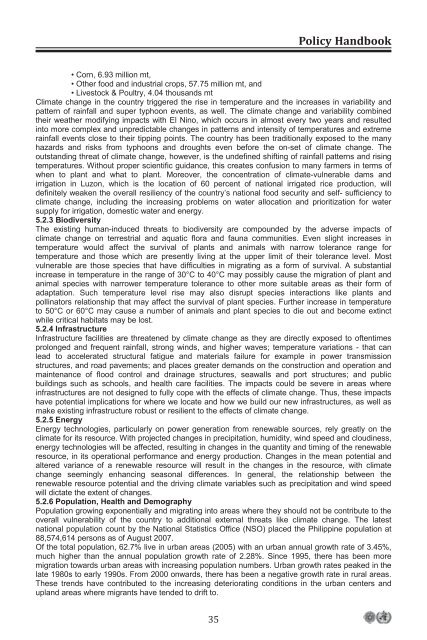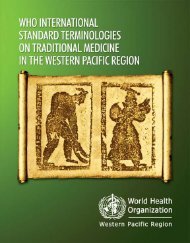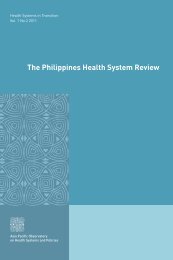Untitled - DOH
Untitled - DOH
Untitled - DOH
- No tags were found...
Create successful ePaper yourself
Turn your PDF publications into a flip-book with our unique Google optimized e-Paper software.
National Framework Strategy on Climate Change Policy 2010-2022 Handbook• Corn, 6.93 million mt,• Other food and industrial crops, 57.75 million mt, and• Livestock & Poultry, 4.04 thousands mtClimate change in the country triggered the rise in temperature and the increases in variability andpattern of rainfall and super typhoon events, as well. The climate change and variability combinedtheir weather modifying impacts with El Nino, which occurs in almost every two years and resultedinto more complex and unpredictable changes in patterns and intensity of temperatures and extremerainfall events close to their tipping points. The country has been traditionally exposed to the manyhazards and risks from typhoons and droughts even before the on-set of climate change. Theoutstanding threat of climate change, however, is the undefined shifting of rainfall patterns and risingtemperatures. Without proper scientific guidance, this creates confusion to many farmers in terms ofwhen to plant and what to plant. Moreover, the concentration of climate-vulnerable dams andirrigation in Luzon, which is the location of 60 percent of national irrigated rice production, willdefinitely weaken the overall resiliency of the country’s national food security and self- sufficiency toclimate change, including the increasing problems on water allocation and prioritization for watersupply for irrigation, domestic water and energy.5.2.3 BiodiversityThe existing human-induced threats to biodiversity are compounded by the adverse impacts ofclimate change on terrestrial and aquatic flora and fauna communities. Even slight increases intemperature would affect the survival of plants and animals with narrow tolerance range fortemperature and those which are presently living at the upper limit of their tolerance level. Mostvulnerable are those species that have difficulties in migrating as a form of survival. A substantialincrease in temperature in the range of 30°C to 40°C may possibly cause the migration of plant andanimal species with narrower temperature tolerance to other more suitable areas as their form ofadaptation. Such temperature level rise may also disrupt species interactions like plants andpollinators relationship that may affect the survival of plant species. Further increase in temperatureto 50°C or 60°C may cause a number of animals and plant species to die out and become extinctwhile critical habitats may be lost.5.2.4 InfrastructureInfrastructure facilities are threatened by climate change as they are directly exposed to oftentimesprolonged and frequent rainfall, strong winds, and higher waves; temperature variations - that canlead to accelerated structural fatigue and materials failure for example in power transmissionstructures, and road pavements; and places greater demands on the construction and operation andmaintenance of flood control and drainage structures, seawalls and port structures; and publicbuildings such as schools, and health care facilities. The impacts could be severe in areas whereinfrastructures are not designed to fully cope with the effects of climate change. Thus, these impactshave potential implications for where we locate and how we build our new infrastructures, as well asmake existing infrastructure robust or resilient to the effects of climate change.5.2.5 EnergyEnergy technologies, particularly on power generation from renewable sources, rely greatly on theclimate for its resource. With projected changes in precipitation, humidity, wind speed and cloudiness,energy technologies will be affected, resulting in changes in the quantity and timing of the renewableresource, in its operational performance and energy production. Changes in the mean potential andaltered variance of a renewable resource will result in the changes in the resource, with climatechange seemingly enhancing seasonal differences. In general, the relationship between therenewable resource potential and the driving climate variables such as precipitation and wind speedwill dictate the extent of changes.5.2.6 Population, Health and DemographyPopulation growing exponentially and migrating into areas where they should not be contribute to theoverall vulnerability of the country to additional external threats like climate change. The latestnational population count by the National Statistics Office (NSO) placed the Philippine population at88,574,614 persons as of August 2007.Of the total population, 62.7% live in urban areas (2005) with an urban annual growth rate of 3.45%,much higher than the annual population growth rate of 2.28%. Since 1995, there has been moremigration towards urban areas with increasing population numbers. Urban growth rates peaked in thelate 1980s to early 1990s. From 2000 onwards, there has been a negative growth rate in rural areas.These trends have contributed to the increasing deteriorating conditions in the urban centers andupland areas where migrants have tended to drift to.3535
















